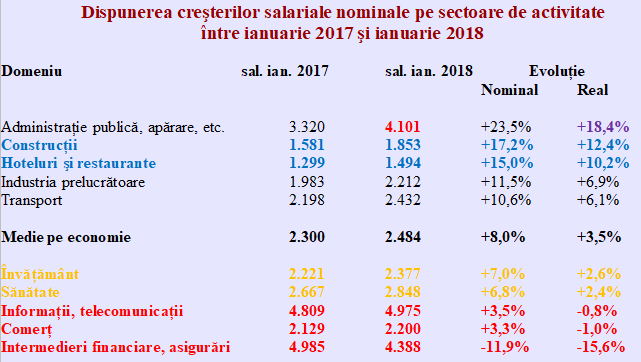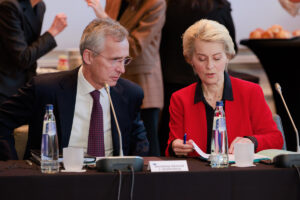 The national gross average wage announced by the INS for January 2018 was 4,143 lei, a value that cannot be compared with the previous month because contributions have been moved from the employer to the employee.
The national gross average wage announced by the INS for January 2018 was 4,143 lei, a value that cannot be compared with the previous month because contributions have been moved from the employer to the employee.
The corresponding net amount declined by 145 lei to 2,484 lei as compared to December 2017, which corresponds to an equivalent purchasing power of 1,063 euros, after adjusting to the local price level.
The real wage (the purchasing power of money earned, expressed as an index compared to October 1990) declined sharply compared to the previous month, from the historical record of 192.9% to 180.9%. Of course, bonuses granted for holidays, which did not happen again for the activity in the first month of the year, had an important role in this evolution.
Net average wage reached this way 533 euros at the average exchange rate of February 2018 (the actual month of payment), which is by no coincidence almost the same as in November 2017. More importantly, though, as previously anticipated, the increase in the purchasing power compared to the same month of the previous year has effectively melted.
After stagnating in 2017 around a level twice the economic growth recorded by Romania, it dropped sharply to just half (3.5%). And this trend will continue in the coming months when inflation will rise, according to the official estimates, to over 5% and will massively cut from the salary increases granted without any solid ground in the increase of labour productivity.
*
- Evolution of national average wage and purchasing power over last 13 months
- Month Net average wage euro/leu Net average wage Purchasing power
*
For conformity, we mention that the values of the purchasing power expressed in euro, as if Romanians had earned the amounts in euro at the European average prices, were recalculated with the new price ratio communicated by Eurostat for Romania, of 50.2% of the benchmark of 100% for the EU28.
REAL wage increases by sectors
Finally, after the race of promises and wage increases that took place in 2017, the highest percentage increases in the national wages were recorded in the public administration. Namely 23.5% in nominal terms and 18.4% in real terms, which means adjusted by the inflation of 4.32%.
Constructions and the segment with the lowest payment, hotels and restaurants, appear with double digits increases at the beginning of the year only because the new minimum national gross wage increased to 1,900 lei and a large proportion of those employed there were receiving this salary. The blue colour was chosen for the situation of the companies with which they work.
Manufacturing and transport are the only industries, otherwise below the national average in terms of payment level, where purchasing power increases are justified in relation to the economic result in 2017. With the mention that the manufacturing industry still did not exceed the critical threshold of 90% of the national economy average, which is also much below the European practice.
*
- Structure of nominal wage increases by sectors between January 2017 and January 2018
- Field Wage, January 2017 Wage, January 2018 Change
- Nominal Real
- Public administration, defence, etc
- Construction
- Hotels and restaurants
- Manufacturing industry
- Transport
- National average
- Education
- Health
- IT & C
- Trade
- Financial intermediation and insurance
*
After all the buzz on the wage increases in the education and health sectors, these sectors woke up to the harsh reality of the tough landing, de facto, below the average national wage growth. Practically, strikes in these sectors are explained by entering a sort of wage withdrawal resulting from the huge discrepancy between the expectations created and the amounts received.
Nominal increases in two other economic sectors, IT and trade (which theoretically should have advanced more clearly both by the increased sales volume and the high proportion of the minimum wages paid) remind of the jokes with Radio Erevan. Where inflation has played in our case the part of reality reversing from being given an extra amount to being taken from salary, in terms of purchasing power.
It is also worth noting the spectacular collapse, both real and nominal, in the financial intermediation sector, which grew strongly at the end of last year (eight percentage points of advance in a single month). After that, it fell, by far, behind wage changes by economic sectors at the beginning of 2018.











